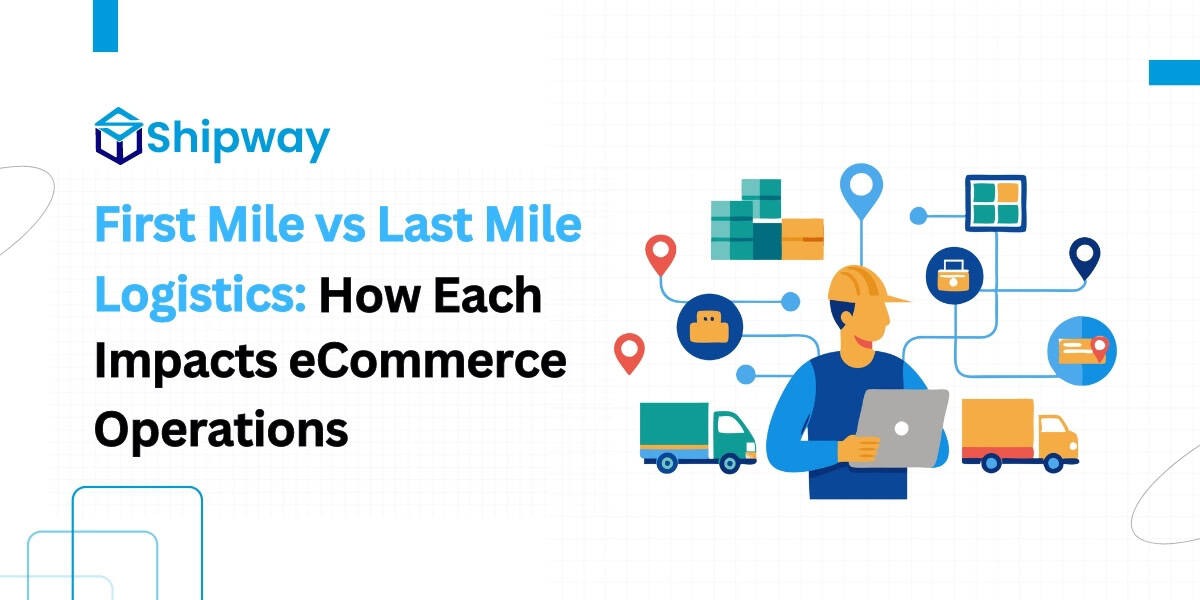Many eCommerce shipping in India might face two challenges including first-mile and last-mile deliveries. First mile delivery and last mile delivery involve the process of starting and completing the shipping cycle. But it is difficult to manage first and last mile logistics, so it is important to look at challenges that help you streamline them for a more efficient supply chain.
What is Meant By First Mile Delivery?
First mile delivery is a process of moving products from the retailer to the courier company. This is the primary step of delivering a product to the customer after ordering. This means, if you ship your products through FedEx, this first mile delivery service will transport the products from your warehouse to its warehouse.
How Does First Mile Delivery Work?
Understanding how the first mile delivery service works involves examining several key components that include sourcing, transportation, technology and logistics management.
1. Sourcing and Pickup
The first step involved in first mile delivery service is sourcing the products from a manufacturer. The goods or products need to be picked up and packaged properly to make sure they are ready for transportation. This stage includes labeling, quality checks, and inventory updates. Also, logistics companies or third-party logistics providers will get involved to make the product pickup process an easy way.
2. Transportation
If the goods are ready to ship, they must be transported from the location of a supplier to a central warehouse. This transportation method can depend on the type of goods or products, distance and urgency. Trucks, vans or cargo bikes may be used for local or short-distance deliveries. But larger shipments may require freight transport by rail or air. The transportation choice plays a key role in knowing the speed, cost and efficiency of the delivery process.
3. Technology Integration
In the supply chain management process, technology plays an important role in managing the first mile delivery. The most advanced software solutions and first mile logistics tracking systems provide real-time visibility of goods. This allows businesses to understand the movement of shipments from the location of the supplier to the warehouse. Also, technologies like GPS tracking, RFID tags, Asset Tags, and IoT devices help in accurate and timely updates and reduce the risk of delays
4. Logistics Management
Good logistics management is always important for first mile delivery. It involves planning routes, scheduling pickups, managing fleets and coordinating with suppliers and distribution centers. This kind of management helps in reducing transit times and costs to ensure that goods or products arriving at the distribution centers are in good condition. Companies also do predictive analytics to know potential issues such as traffic delays, inventory shortages or weather disruptions, to make better decisions.
Challenges and Optimization
First mile delivery has many challenges that include coordinating multiple suppliers, handling lots of shipments and maintaining timely pickups. Therefore, companies always collaborate with experienced logistics partners and use data analytics to improve routing and scheduling. The efficient first mile process ensures a smooth supply chain flow that also enhances customer satisfaction.
What is Meant By Last-Mile Logistics Service?
Last mile delivery is the final step involved in the process of shipping. All the packaged goods or products are transported directly from the warehouse of the courier company to the customer’s doorstep. Similarly, if you’re using FedEx, last-mile delivery means FedEx transporting the product from their warehouse to the customer’s home.
How Does Last Mile Delivery Work?
Understanding how the process of last mile logistics trends works involves analyzing the key steps, challenges and technological advancements involved in the process.
1. Order Processing and Sorting
The process of last mile shipping starts when a customer places an order. Once the order is received, the items or products will be packed, and then they will be sorted at a distribution center. The process of sorting is the most important step where orders are grouped based on delivery locations to ensure easy route planning. This step also reduces transit time and helps in optimizing resources like fuel and labor.
2. Route Optimization and Dispatching
After sorting, the next step is to make delivery routes very clear. Route optimization involves using algorithms, software tools, and a multi drop route planner to determine the easiest path for delivery drivers by considering distance, traffic and delivery windows. These routes help in reducing fuel consumption, delivery time and operational costs. Once the routes are planned, the couriers are dispatched to deliver the orders.
3. Real Time Tracking and Communication
Technology is playing an important role in last mile logistics services. They are real-time order tracking systems that provide both the customer and the logistics company with live updates and also the status of the delivery. GPS enabled devices and even communicate with the delivery driver. This level of transparency is building trust and improving customer experience.
4. Delivery to the End Customer
The next step in last mile delivery is delivering the items to the address of the customer. This can involve multiple delivery attempts if the customer is unavailable, or in some cases, leaving the package at a safe location or with a neighbor. Delivery personnel are trained to handle goods carefully, ensure proper handover, and collect feedback if necessary. Some companies also offer contactless delivery options, especially in densely populated urban areas.
Challenges and Solutions
There are many challenges that last mile delivery processes face such as high delivery costs, traffic congestion and failed delivery attempts. To fix these issues, companies are increasingly moving to advanced solutions like delivery drones, autonomous vehicles and locker systems. These technologies also help reduce shipping costs, improve delivery speed and improve the efficiency of the service.
Challenges in First-Mile Delivery
As already discussed, there will be many challenges that need to be faced by first-mile delivery service providers. Some of the challenges are listed below:
1. Labeling
One of the main challenges in the first mile delivery service is proper labeling. Many sellers do not know the importance of correct labels and depend on handwritten ones. This kind of incomplete information can cause delays in pickup by courier companies. Some of the shipping solutions like Shipway offer automated label generation includes all the necessary details to help you create accurate labels and also speed up the process.
2. Packaging
Packaging is another challenge faced by the first mile delivery process. In some cases, sellers do not follow the proper packaging standards which results in packages that are not packed properly or use weak materials. This kind of packaging can cause delays when transferring the package from the retailer to the courier company.
3. Traffic and Lack of Resources
We all know that the traffic in India is not predictable, and several regulations affect the transportation of goods. It is important to plan pickups carefully and avoid delays. Additionally, the shortage of trained staff to inspect packages at pickup can further slow down the process.
4. Incorrect Details
Incomplete buyer information is another common issue. Without accurate details, courier companies may struggle to process orders promptly. Inaccurate information can also lead to products being held up at customs or during interstate transport.
Challenges in Last-Mile Delivery
Some of the biggest challenges in last mile delivery services worldwide include responding to last-minute changes, reducing logistics costs and ensuring on-time delivery. In India, the wide geographical landscape will add another layer of difficulty. Here are a few common challenges:
1. Cost
The high shipping cost involved in the last mile delivery service is the main issue. Many companies charge extra for this service, which is not always affordable for customers. The effective management of these costs has become a big challenge due to the rise of omnichannel retail and same-day delivery demands.
2. Granular Tracking
The tracking of our packages throughout the delivery process is another major challenge. Customers should know the exact status of their orders, but tracking every shipment in real time until it reaches the buyer can always be challenging. Companies like Swiggy and Zomato have mastered this with their last mile delivery model, but eCommerce still has to improve.
3. Fast Deliveries
Fast delivery of items may not always be possible due to heavy traffic and insufficient roads. Also, in cities such as Bangalore and Mumbai, traffic jams cause delays in delivering items for up to 2 to 3 hours. In small cities, poor road conditions and a lack of advanced technology in the supply chain can also cause delays.
Conclusion
First mile and last mile deliveries are the most important components of your supply chain. To ensure faster deliveries and greater customer satisfaction, it is important to focus on managing these processes and addressing the challenges they present. By optimizing both stages, you can streamline operations, reduce costs, and enhance overall logistics efficiency.
Ready to streamline your last-mile delivery? Choose Shipway’s comprehensive last-mile logistics solution and take your eCommerce business to the next level.



